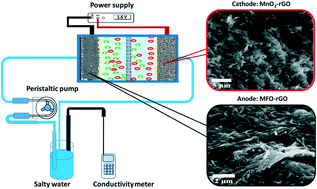Asymmetric configuration of pseudocapacitive composite and rGO electrodes for enhanced capacitive deionization†
Abstract
The common CDI cells employ a symmetric electrode pair configuration consisting of two identical carbon electrodes. Herein, we investigated the use of an electrode pair consisting of two different electrodes as an asymmetric configuration, such as a pseudocapacitive positive electrode paired with a carbon negative electrode. The pseudocapacitive spinel compounds of cubic MnFe2O4 and rod-like α-MnO2 nanocrystals were synthesized initially and then incorporated with GO nanosheets to obtain the MnFe2O4–rGO composite (30 wt% rGO) and MnO2–rGO composite (40 wt% rGO) via a hydrothermal process, respectively. It was found that the specific capacitance values at all scan rates were higher for the composite electrodes than for the individual metal oxide electrodes. This indicates that the rGO component provided additional surface area for the formation of an electrical double layer (EDL) and integrated well with the pseudocapacitive/Faradaic component to enhance the electrosorption performance. A CDI cell consisting of two distinct electrodes in an asymmetric configuration was fabricated, and it was found that MFO–rGO as the negative electrode and rGO as the positive electrode had the fastest average salt adsorption rate of 22.07 μg g−1 s−1 since the rGO negative electrode maintained the fast electrosorption and desorption rate via the electrical double layer mechanism. However the salt adsorption capacity of 29.44 mg g−1 was not as high as that of the pseudocapacitive composite/composite electrode pair. The electrode pair of two pseudocapacitive composites, i.e., MFO–rGO/MnO2–rGO had the highest salt adsorption capacity of 38.28 mg g−1, which is due to the synergistic pseudocapacitive/EDL effect for achieving high salt adsorption capacity, whereas it demonstrated the second fastest average salt adsorption rate of 20.8 μg g−1 s−1 due to the greater influence of diffusion charge transfer by the Faradaic mechanism. Finally, for the electrode pair of MnO2–rGO/rGO, both its salt adsorption capacity and rate of 21.16 mg g−1 and 14.39 μg g−1 s−1, respectively, were the lowest among the three pairs. The water productivity, and the energy consumption were calculated to evaluate the CDI performance, and the results were consistent with the trend of the average salt adsorption rates (ASAR). This study demonstrates that an electrode pair made of two different electrodes such as pseudocapacitive spinel composites and rGO is a promising arrangement to enhance the capacitive deionization process.

- This article is part of the themed collection: Capacitive deionisation and electrosorption 2020


 Please wait while we load your content...
Please wait while we load your content...